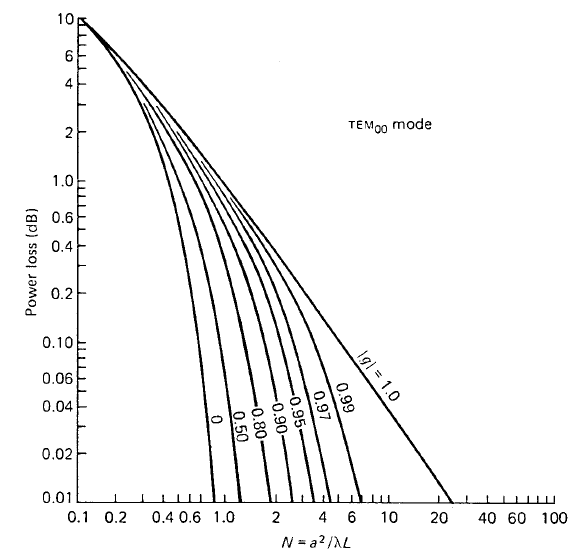


 الفيزياء الكلاسيكية
الفيزياء الكلاسيكية
 الكهربائية والمغناطيسية
الكهربائية والمغناطيسية
 علم البصريات
علم البصريات
 الفيزياء الحديثة
الفيزياء الحديثة
 النظرية النسبية
النظرية النسبية
 الفيزياء النووية
الفيزياء النووية
 فيزياء الحالة الصلبة
فيزياء الحالة الصلبة
 الليزر
الليزر
 علم الفلك
علم الفلك
 المجموعة الشمسية
المجموعة الشمسية
 الطاقة البديلة
الطاقة البديلة
 الفيزياء والعلوم الأخرى
الفيزياء والعلوم الأخرى
 مواضيع عامة في الفيزياء
مواضيع عامة في الفيزياء|
Read More
Date: 23-1-2021
Date: 11-4-2016
Date: 29-1-2021
|
Diffraction Losses
In any real laser resonator some part of the laser beam will be lost either by spillover at the mirrors or by limiting apertures, such as the lateral boundaries of the active material. These losses will depend on the diameter of the laser beam in the plane of the aperture and the aperture radius. If we take a finite aperture of radius a within the resonator into account, the diffraction losses depend on four parameters, R1, R2, L, and a, which describe the resonator; and on three parameters λ, m, and n, characterizing the particular mode present in the resonator. Fortunately, the losses depend only on certain combinations of these parameters. These combinations are the so-called Fresnel number, rameters λ, m, and n, characterizing the particular mode present in the resonator.
Fortunately, the losses depend only on certain combinations of these parameters.
These combinations are the so-called Fresnel number,
 ........(1)
........(1)
and the quantities g1 and g2. The parameter N can be thought of as the ratio of the acceptance angle (a/L) of one mirror as viewed from the center of the opposing mirror to the diffraction angle (λ/a) of the beam. Therefore, when N is small, especially if N < 1, the loss factor will be high because only a portion of the beam will be intercepted by the mirrors.
Conversely when N is large, diffraction losses will be low. The fractional energy loss per transit because of diffraction effects for the lowest-order mode (TEM00) is shown in Fig. 1 for resonators with equally curved mirrors and apertures located in front of the mirrors (g1 = g2 = g, a1 = a2 = a). The plane-parallel and concentric resonator (|g| = 1) have the highest losses for a

FIGURE 1. Diffraction losses per transit for the TEM00 mode of various symmetrical
resonators.
given aperture according to Fig. 1. This is not surprising because both resonator configurations have mode sizes which approach infinity at the limit. On the other hand, the confocal resonator (g = 0) has the smallest mode dimension for a given resonator length as discussed before. Therefore a given aperture will also cause the lowest diffraction losses. It can also be seen from Fig. 1 that the diffraction losses are very sensitive to changes in mirror curvature, and losses decrease very rapidly for all resonator configurations as N increases.
Mode selection or discrimination of higher order modes, by choosing the appropriate Fresnel number, that is, intracavity aperture. In this figure, the diffraction losses in a confocal resonator for a number of low-order modes are plotted versus the Fresnel number. For N = 1, only the TEM00 and the TEM01 modes have a power loss per transit of less than 1% per pass. All other modes have losses above 10%. A laser with this resonator would emit on only these two modes if the gain per pass were less than 10%. Single-mode emission would require a slightly smaller aperture to reduce the value of N just under 1. Going in the other direction, if the aperture is increased by about a factor of 1.4 in diameter to yield F = 2, then 10 modes from TEM00 to TEM05 have less than 1% loss per transit. This resonator would clearly have a multimode output.



|
|
|
|
التوتر والسرطان.. علماء يحذرون من "صلة خطيرة"
|
|
|
|
|
|
|
مرآة السيارة: مدى دقة عكسها للصورة الصحيحة
|
|
|
|
|
|
|
متحف الكفيل ينظم ندوة علمية عن متحف الأرميتاج الدولي
|
|
|